Greg O’s Garage: Removable rims and their impact on early motoring and racing
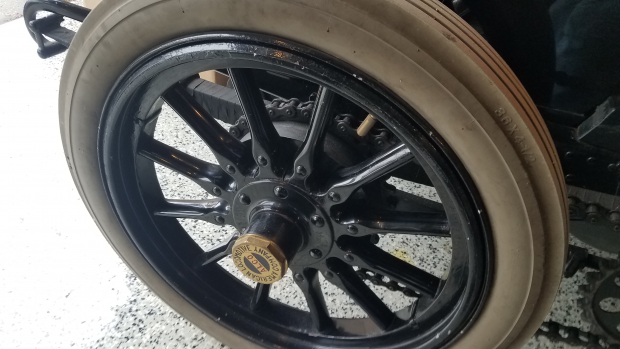
Please give a big welcome to VanderbiltCupRaces.com columnist Greg Oreiro.
Greg O's Garage first post: Sometime in 1904/1905, the idea of having a pre-mounted tire and tube with air on a removable rim was beginning to take form. And unlike today, it was a big deal then.
In the early 1900's, innovations were happening practically on a daily basis in the automotive world. Things we consider 'cutting edge' tech these days, and conversely, mundane items, were seemingly the opposite 115 years ago. Today, we consider electric vehicles the latest tech in the automotive world, but in reality, electric vehicles have been around just as long as internal combustion vehicles. In 1905, there were several manufacturers building battery powered electric cars, but yet, we didn't have something as simple as a speedometer, or odometer yet as an example. (both invented sometime around 1905).
One of those mundane items that many people don't even think about, is the spare tire that comes in the trunk of almost every vehicle on the road. Many modern tires are even considered 'run-flat' meaning they can be driven on even with complete loss of air. However, before 1905, having a flat tire on the road meant physically removing the tire and inner tube from the wheel, and mounting a new tire and tube right there on the road. Not a convenient thing to do for sure.

There were some minor mentions of the idea in 1904, but one of the earliest mentions could be found in The Motor in October 1905. Claiming to be an "English idea' that only took 'three of four minutes' and that 'the idea should become a popular one'. The 'idea' was simply to mount the inflated tube and tire on a metal ring that could be slid on to the perimeter of the wooden artillery style wheel and secured. This took the same amount of room as a regular spare tire and was a clever solution. A less ideal method of dealing with punctures mentioned at the bottom of the page was to place two semi-inflated tubes in the tire on top of each other so when the outside tube was punctured, the inner of the 2 tubes could be fully inflated to take up the space of the now deflated outer tube. I think we know now 115 years later which idea was the better of the two.
While touring cars would eventually benefit, race cars of the time were the first to see the advantage of removable rims. The necessity for being quick to change flat tires during a race often times can decide the outcome of a race even today. All following articles taken from Automobile Topics July-Oct 1906.

The French Grand Prix in 1905 was one of the first races bringing much interest in the removable rim with Ferenc Szisz winning on removable Michelins. More French races also further cemented their racing usefulness. "...it must be admitted that the old...style of non-removable rims is hopelessly archaic." "...[non-removable rims] will be, as extinct as the Dodo."
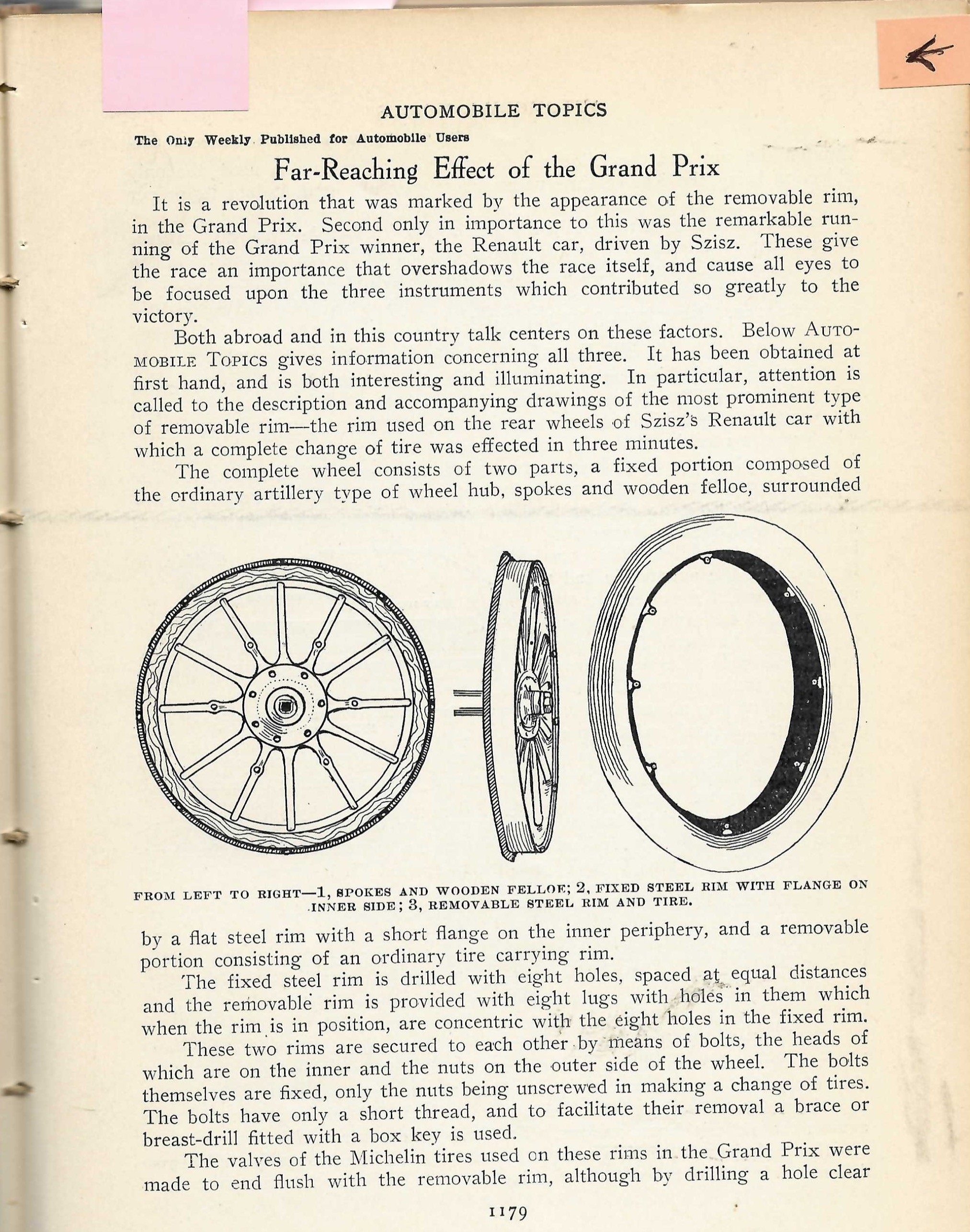
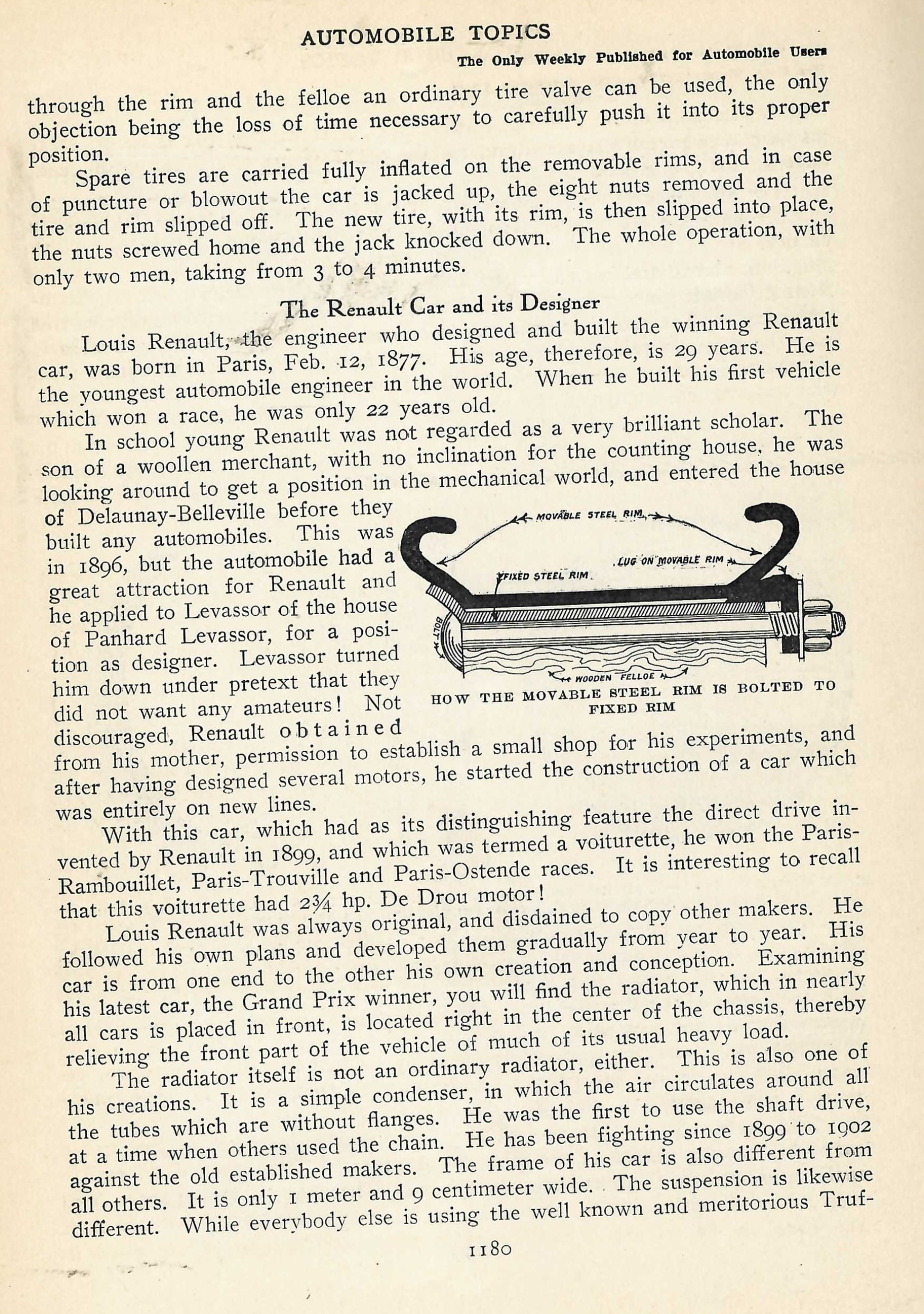



For the French Grand Prix only that year, all repairs and fueling on the car during the race could only be handled by the mechanician and the driver, and not the usual multi-man crews. . Removable rims were certainly a huge advantage there with tires needing to be changed after only a few turns around the track..


Warnings to American manufacturers to start building removable rims or they will be "handicapped by the foreign car."


For the Belgian Ardennes Race mentioned above, all but Victor Hemery were using removable rims.

With the upcoming 1906 Vanderbilt Cup Races looming, the Americans did listen. Unique front-wheel drive innovator, Walter Christie of course needed to engineer his own style of removable rim which removed the spokes.

Michelin started offering their rims in the U.S. in 1906.



U.S. manufacturer Diamond Rubber got into the quick change game with their own design. The even had a White manufactured steam delivery wagon to bring employees and tires to tire stations around the Vanderbilt Cup race course.

Initially, as mentioned many times during the 1906 season, it was thought that the removable rim was an unfair advantage and not be allowed. But the Vanderbilt cup commission convened and were quick to state there was nothing in the rules to prevent them, and they were an "...important and modern fitting."

Hartford Rubber had their own ideas as well and quick detachable tires featuring a quick change turnbuckle style ring to secure the tire.

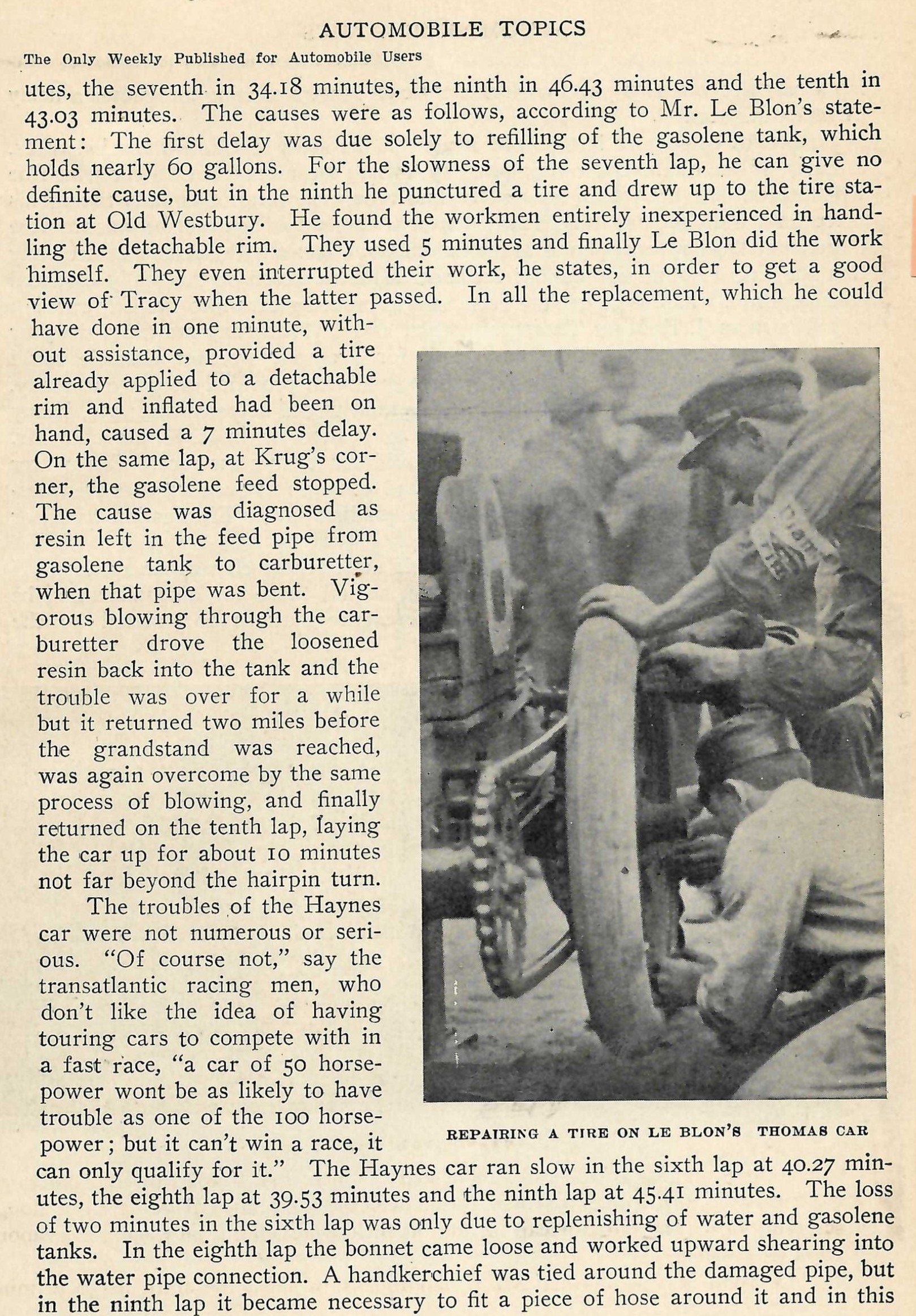
Surprisingly, during the 1906 American Elimination Trial, Hubert LeBlon experienced more time lost due to the removable rim. When he had a puncture, he found himself at the Old Westbury tire station with a tire crew unfamiliar with the removable rim. After 5 minutes, he ended up changing the tire himself.
Despite the setback, it seems that the removable rim would soon become the norm and eventually become the spare tire in your trunk.
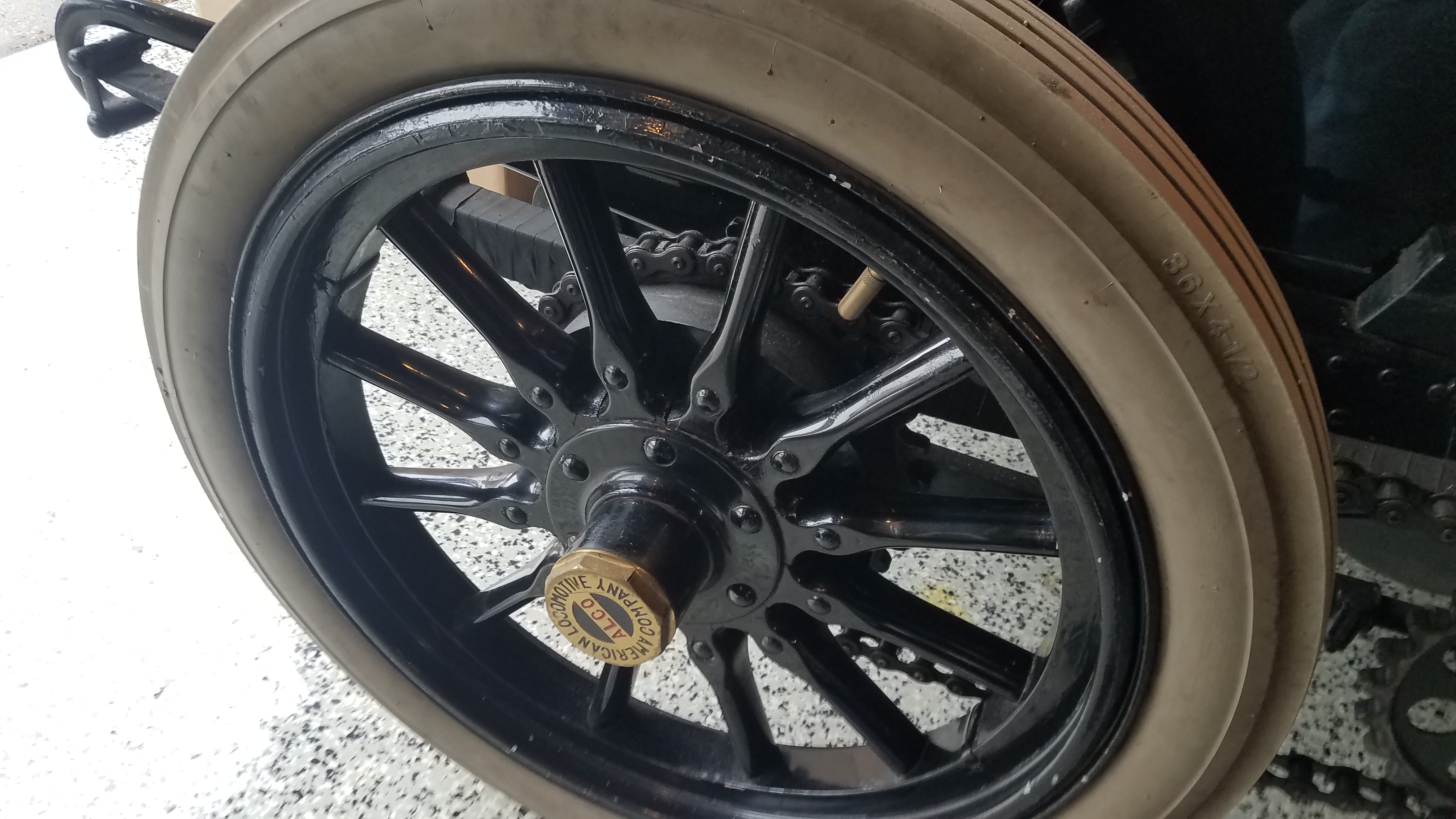
Surprisingly, the Black Beast is NOT equipped with removable rims.










Comments
Interesting info, Greg. Congrats with your new role here!
Thanks Brian!
Between Howard, Art, and 13 years of the rest of us following Sam III and Al V., the bar is pretty high!
Greg, ....IT’S ABOUT TIME ! Congrats, good luck and thanks for sharing.
Great post Greg. Amazing info!
This is a really interesting post on a subject not often mentioned. Detachable rims were of course common in the US (often an identification feature to determine if a car is American or European), and many types were developed in the US. In Europe detachable rims were only one of the systems to facilitate tire replacement. Michelin was one of the European firms who designed detachable rim systems, which were commonly applied in the years before the Great War.
During the Vanderbilt Cup races of 1909 and 1910 the majority of the participants used Michelin tires in combination with the by Michelin specially designed quickly detachable racing rims. Also the Alco used these, as the contemporanean photos of the Alco racer show. However they probably have been replaced at some moment in the past. These racing rims appear to have been lost almost completely, but one surviving racer is still equipped with them: the 1913 Mercer belonging to the Simeone Foundation.
I added an article in The Automobile of January 7, 1909 with a short description of these racing rims, a few photo’s of the original rim and a photo of the unlocking system on the Simeone Mercer. Of course it would be interesting to research if it would be possible to provide the Alco with this system again!
The 1913 Mercer racing rim unlocking system
Ariejan, Thanks for the additional information. Always welcome your input.
Christie patented his wheel in France. Here is a modern re-creation. Yes, the entire wheel center and brake drum are one piece, cast iron.
Great post, Greg !
Just realized they must’ve had clocks in mind with the development of the rims. A spoke for every hour.
From my research, the 1906 Locomobile, old 16, lost several races due to tires walking off the rims and the decision was made to fit detachable rim wheels to the car but like the Black Beast, it does not have detachable rim wheels today. If old 16 ever was fitted with detachable rim wheels, it was quickly switched back.
It might be of interest to note tires of this period were much more flexible and could easily walk off the rim, especially under race conditions. Most tires were of the clincher variety, captured on both sides by the rim, but the tires still walked off the rims. I suspect the decision was made to run Michelin tires instead of converting the wheels. Michelin tires were much more reliable.
A few more photos originally intended for the post, but never made it. Courtesy of the Detroit public library. First 3 being the Dow removable wheel. The following pictures are self explanatory by their captions. My favorite being the ‘in action’ Spooner and Wells shot during the VCR.
Vanderbilt Cup Races
And lastly, the Healy demountable tire.
Lee, Interesting photo. Curious about that recreation. The use of Firestone anti-skid tires and attached brake drum are very different to an original Christie wheel seen here in 1906. Maybe it was recreated from a later design.
Found this picture which unfortunately is not dated.
Art, odds are it is also 1906 when they were developed.
As brilliant as Walter Christie was, his demountable wheel is a little strange. With 12 spokes and a post and bolt at each end, that to me seems more time consuming to change, than for instance, the Mercedes wheel with a mounting ring around the spokes and only 8 bolts. With the Christie, 12 bolts need to be removed and then carefully lined back up to the spokes to reinstall. The Mercedes just quickly places the ring mounted to the tire anywhere to the ring around the spokes and the 8 bolts reinstalled. I’d bet that a tire change on the Mercedes was much faster than a Christie change.
Greg, the modern recreation wheel that I posted above is Christie’s final racing car of 1909. It’s a current photo from the complete car recreation which is underway as we speak. Christie’s wheel patent shows the bracket details. I think the problem with Christie’s wheel is that the spokes are a casting, so the 12 spokes are unlikely to come from the foundry exactly equally spaced about 360 degrees. That requires machining each casting perfectly so all the rims and wheels are interchangeable. My email is leestohr at teleport.com if you wish to discuss further. Your in depth research on this subject is excellent and fascinating to me, at least.
Greg, the michelin photos above are from the French National library, Gallica. Google it if you are not familiar. Wonderful hi-res photos are available online for free.
Thanks Lee!